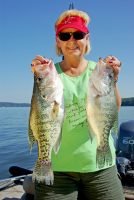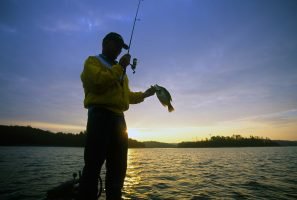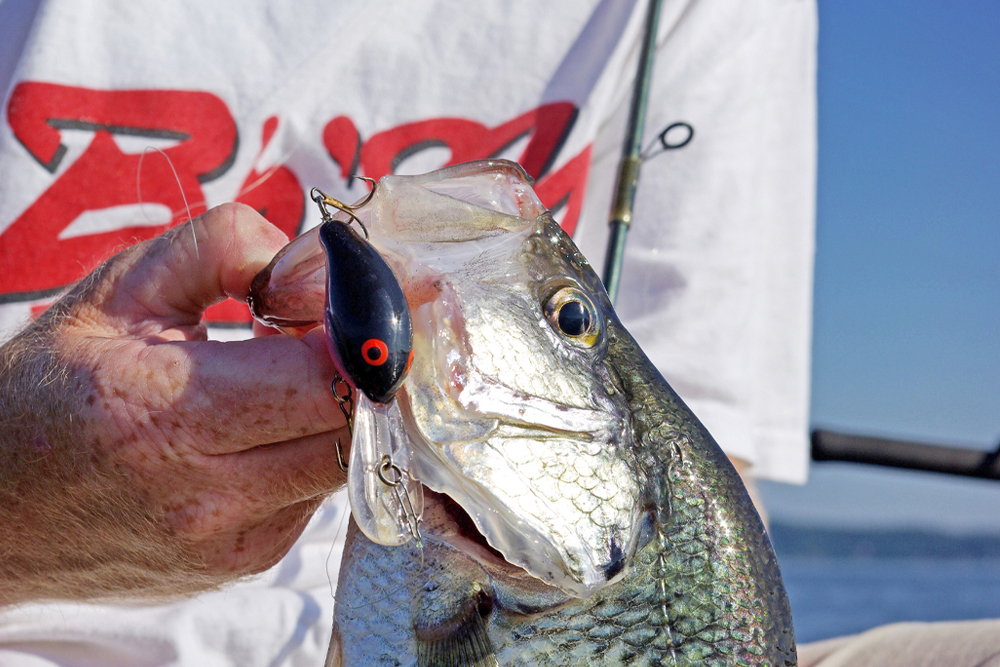Trolling crankbaits is a great technique for locating slab crappie in Fort Loudoun
or Chickamauga Lakes. Both lakes are literally in the backdoor of major metropolitan
areas, although surprisingly, not many crappie anglers use this productive technique.
Big-City Crappie: Urban Hotspots You Can Reach Fast
Story and photos by Keith Sutton
Living in a big city doesn’t mean you have to travel over hill and dale to reach great crappie water. Fortunately for many anglers, there are lots of crappie sweet spots close to town.
Here we will focus on four of Tennessee’s largest metropolitan areas – Memphis, Nashville, Chattanooga and Knoxville.
If you didn’t know, nearly 70 percent of the U.S. population lives within a day’s drive of Tennessee. Folks who live or visit there can find world-class crappie fishing just a short drive away. Whether you prefer casting in the shade of a quiet cove, trolling open water or dipping jigs in submerged brush, these hotspots offer excellent opportunities for summer slabs.
Nashville: Woods Reservoir
A short drive southeast of Nashville is a small hidden crappie-fishing gem – the 3,980-acre Woods Reservoir, offering some of the best crappie action in Middle Tennessee. Located on the Elk River near Manchester, this lake produces high numbers of crappie, with most fish in the 10- to 12-inch range and occasional slabs pushing beyond that.
In summer, crappie settle into deeper water, often suspending along the Elk River channel and old creek channels from the Morris Ferry Bridge to the Bradley Creek area. Anglers who locate brushpiles in these deeper sections often enjoy steady action. Electronics play a huge role in finding crappie this time of year, as schools tend to group up in 15 to 25 feet of water near submerged trees and artificial fish attractors placed by the Tennessee Wildlife Resources Agency (TWRA).
One effective technique is slow trolling with double-minnow rigs or jigs tipped with shiners. This allows anglers to cover a lot of water while maintaining a consistent depth. Another productive method is vertical jigging around standing timber, where crappie often suspend in the shade. Bright-colored jigs—chartreuse, pink, and white—tend to perform best in Woods Reservoir’s somewhat stained water.
The TWRA ranks Woods as one of the state’s top crappie lakes based on per-acre production. While it may not be known for giant slabs, the sheer numbers of legal-sized crappie make it a reliable fishery. The daily limit is 15 crappie, with a 10-inch minimum length requirement.
Woods Reservoir is easily accessible from Interstate 24 via the Arnold Air Force Base exit (117) at Manchester. For an excellent interactive map, click here.
Of course, you’ll also find good crappie fishing at Old Hickory Lake or J. Percy Priest in the city limits of Nashville. But venture onto these lakes in the summer and you should expect lots of company in the form of recreational boat traffic.

Knoxville: Fort Loudoun Lake
Fort Loudoun Lake, a 14,600-acre Tennessee River reservoir, runs right through Knoxville, making it an ultra-convenient fishing destination for local anglers. This sprawling lake extends 55 miles upstream from the dam to the confluence of the Holston and French Broad rivers, offering abundant crappie habitat.
In summer, crappie can be found in both deep and shallow water, depending on the time of day and water temperature. Early morning and late evening, anglers have success in shaded coves such as Ish Creek and Gallaher Creek, as well as the Concord and I.C. King Park areas. Midday, crappie retreat to deeper brushpiles and submerged timber, where they can be targeted with drop-shot rigs or vertically jigged tube baits.
Trolling small crankbaits or spider-rigging with jigs and minnows are particularly effective techniques for locating fish. Some of the best areas to target are bridge pilings, submerged creek channels and TVA-maintained fish attractors. Many anglers also fish around docks, using long rods to reach under overhangs where crappie often stack up in the shade.
The lake’s location within the Knoxville metropolitan area makes it easy to access, with numerous boat ramps and shoreline fishing areas available. It’s a popular summer destination not only for crappie fishing but also for bass, catfish and recreational boating, so anglers should plan their trips for early morning or weekdays to avoid heavy traffic. The TWRA website includes an excellent map.
The crappie limit on Fort Loudoun is 15 per day (black and white crappie combined), with a 10-inch minimum length limit.
Chattanooga: Chickamauga Lake
The southern end of Chickamauga Lake, another Tennessee River reservoir, is inside the city limits of Chattanooga. However, this impoundment extends 60 miles north, so it’s not hard to escape the city traffic.
Local guides call Chickamauga a well-kept crappie secret. The lake has grown famous for its world-class bass fishing since the state wildlife agency began stocking Florida bass fingerlings there 25 years ago. But the same productive water that grows big bass also produces great crappie fishing.
Multiple summer techniques will work, including trolling crankbaits. Surprisingly not many anglers use this productive technique on the Tennessee River, but you can read how Capt. Scott Lillie does it here.
Another tried-and-true Chickamauga technique is dock shooting. There are tons of boat docks, especially on the lake’s south end. Many of those docks provide great shade close to deep water and serve as a haven for crappie. You can watch the technique at work here:
Finally, don’t ignore the deep structure. Along river and creek channels you can find stumps, wood structure or often brushpiles that hold fish throughout the summer.
Memphis: Sardis Lake
Okay, this lake is not in Tennessee but it’s just a long cast away from the bustling blues city of Memphis, and home to the grandest Bass Pro Shop in the world.
If you’re in Memphis and looking for an easy day trip with a high chance of success, Sardis Lake just over the state line in north Mississippi is the place to be. Located 50 miles south of the city, this 32,100-acre reservoir is famous for producing slab crappie up to 2 pounds and beyond.

During summer, crappie spread out into deeper water, often suspending along creek channels in Hurricane, Toby Tubby and Clear creeks. Anglers using spider-rigging techniques with multiple rods and jigs or minnows often do well in these areas. A popular approach is to target submerged stake beds and brushpiles in 12 to 20 feet of water, where crappie gather to escape the heat. The Corps of Engineers maintains several marked fish attractors, which are great starting points for anglers unfamiliar with the lake.
On the north side of the lake, smaller creeks and coves between points like Moccasin and Hayes Crossing hold good numbers of fish, particularly in the mornings and evenings when crappie move up to feed. Deep-diving crankbaits trolled at slow speeds can also be effective in the open water, especially when targeting bigger crappie that suspend at mid-depths.
Sardis Lake is part of Mississippi’s “Big Four” crappie lakes (along with Arkabutla, Enid, and Grenada). New crappie regulations on all four of these flood-control reservoirs went into effect on July 24, 2024. The daily creel limit for crappie is 10 fish per angler, and the daily aggregate limit is 25 fish for boats with three or more anglers. Crappie must be over 12 inches, and the pole limit remains at four per angler.
Sardis Dam is accessible from several exits off Interstate 55, including Como (Exit 258), Sardis (Exit 252), Batesville (Exit 246) and Oxford (Exit 243A). Regular fishing reports and an interactive lake map are available here..
Easy Access to Big-City Slabs
Tennessee crappie anglers don’t have to go far to find top-notch fishing. Whether you live in any of the three major metro area – or pay them a visit – there’s a prime crappie destination within an hour’s drive. Summer brings unique challenges, but with the right approach, you can still fill a limit and enjoy a great day on the water.
Understanding seasonal crappie behavior, using the right techniques and adjusting your strategy based on conditions can make all the difference. Early morning and late evening hours typically offer the best bite, while midday fishing requires targeting deeper water. Electronics are invaluable tools for locating schools of fish, and techniques like spider-rigging, vertical jigging and trolling crankbaits can be highly effective.
So, pack your gear, grab some jigs or minnows and hit the water. These lakes promise some of the best summertime crappie fishing – just a short drive from the city but a world away from the hustle and bustle.
Arkansas outdoor writer Keith Sutton is the author of “The Crappie Fishing Handbook: Tackle, Lures, Bait, Cooking, Tips, Tactics and Techniques,” recently reprinted by Skyhorse Publishing. At 198 pages, this is one of the biggest and best books about crappie fishing ever published—the first full-color fishing guide for everyone who loves catching America’s favorite panfish.


